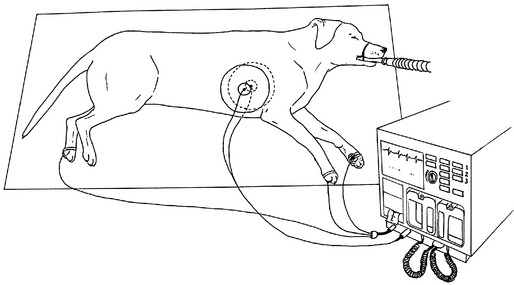P
Pacemaker: Transthoracic Cardiac Pacing
INDICATIONS
EQUIPMENT, ANESTHESIA
PREPARATION: IMPORTANT CHECKPOINTS
POSSIBLE COMPLICATIONS AND COMMON ERRORS TO AVOID
PROCEDURE
ALTERNATIVES AND THEIR RELATIVE MERITS
 PACEMAKER: TRANSTHORACIC CARDIAC PACING Illustration of anesthetized, laterally recumbent dog with properly placed electrode patches and connection to pacing system.
PACEMAKER: TRANSTHORACIC CARDIAC PACING Illustration of anesthetized, laterally recumbent dog with properly placed electrode patches and connection to pacing system.(Courtesy DeFrancesco TC, et al: Noninvasive transthoracic temporary cardiac pacing in dogs. J Vet Intern Med 17:663–667, 2003.)
Parenteral Nutrition
INDICATIONS
Animals in need of nutritional support when:
CONTRAINDICATIONS
EQUIPMENT, ANESTHESIA
PREPARATION: IMPORTANT CHECKPOINTS
POSSIBLE COMPLICATIONS AND COMMON ERRORS TO AVOID
PROCEDURE
Sample PN Worksheet for a 17.5 kg (39 lb) Dog: Centrally Administered PN Calculation
| CANINE HIGH-PROTEIN REGIMEN | |
|---|---|
| Weight: 17.5 kg | Resting energy requirement (RER) = 600 kcal/day |
| Day 1 goal | 50% RER = 0.5(600) = 300 kcal |
| Day 2 goal | 100% RER = 600 kcal |
| % Protein calories | 25% |
| Nonprotein calories | 50% from lipid, 50% from dextrose |
There are 4 kcal/g protein; therefore, the animal needs 18.75 grams of protein: (75 kcal ÷ 4 kcal/g = 18.75 g). | |
50% dextrose to provide 50% nonprotein calories = 112.5 kcal. 50% dextrose solution = 1.7 kcal/mL; therefore, the animal needs 66 mL 50% dextrose solution: (66 mL = 112.5 kcal ÷ 1.7 kcal/mL). | |
Dosed at 8 mM/1000 kcal delivered; therefore, the animal needs 2.4 mM potassium phosphate: (2.4 mM = [8 mM × 300 kcal] ÷ 1000 kcal). | |
POSTPROCEDURE
Chan DL. Parenteral nutritional support. In: Ettinger SJ, Feldman EC, editors. Textbook of veterinary internal medicine. ed 7. St Louis: Elsevier; 2010:701-707.
Chan DL, Freeman LM, Labato MA, et al. Retrospective evaluation of partial parenteral nutrition in dogs and cats. J Vet Intern Med. 2002;16(4):440-445.
Pyle SC, Marks SL, Kass PH. Evaluation of complications and prognostic factors associated with administration of total parenteral nutrition in cats: 75 cases (1994-2001). J Am Vet Med Assoc. 2004;225(2):242-250.
Pericardiocentesis
CONTRAINDICATIONS
Small volume of pericardial effusion (difficult to safely enter the pericardial space)
EQUIPMENT, ANESTHESIA
PREPARATION: IMPORTANT CHECKPOINTS
POSSIBLE COMPLICATIONS AND COMMON ERRORS TO AVOID
PROCEDURE
Stay updated, free articles. Join our Telegram channel

Full access? Get Clinical Tree






